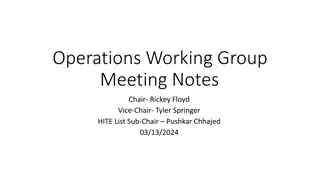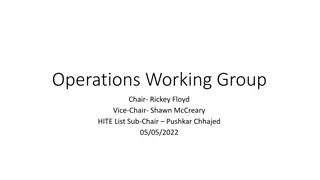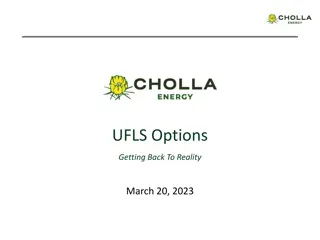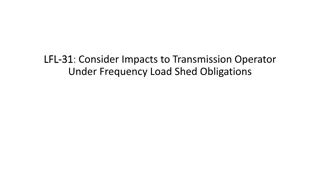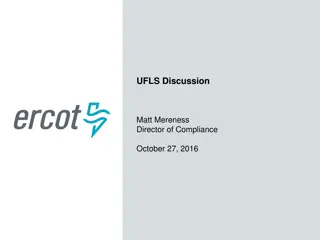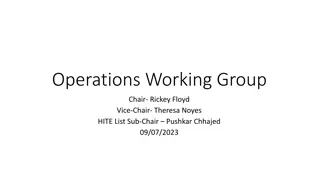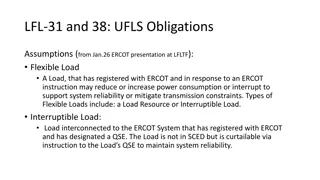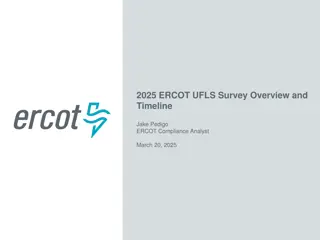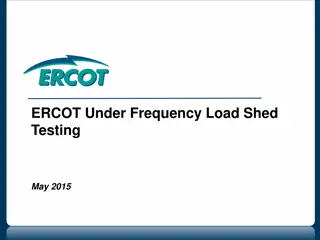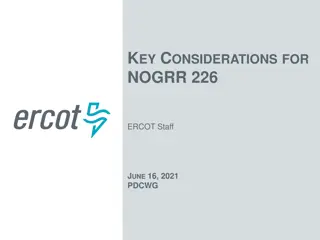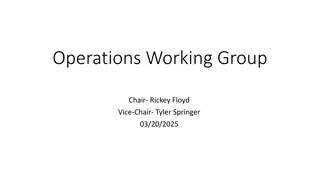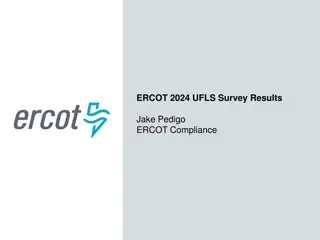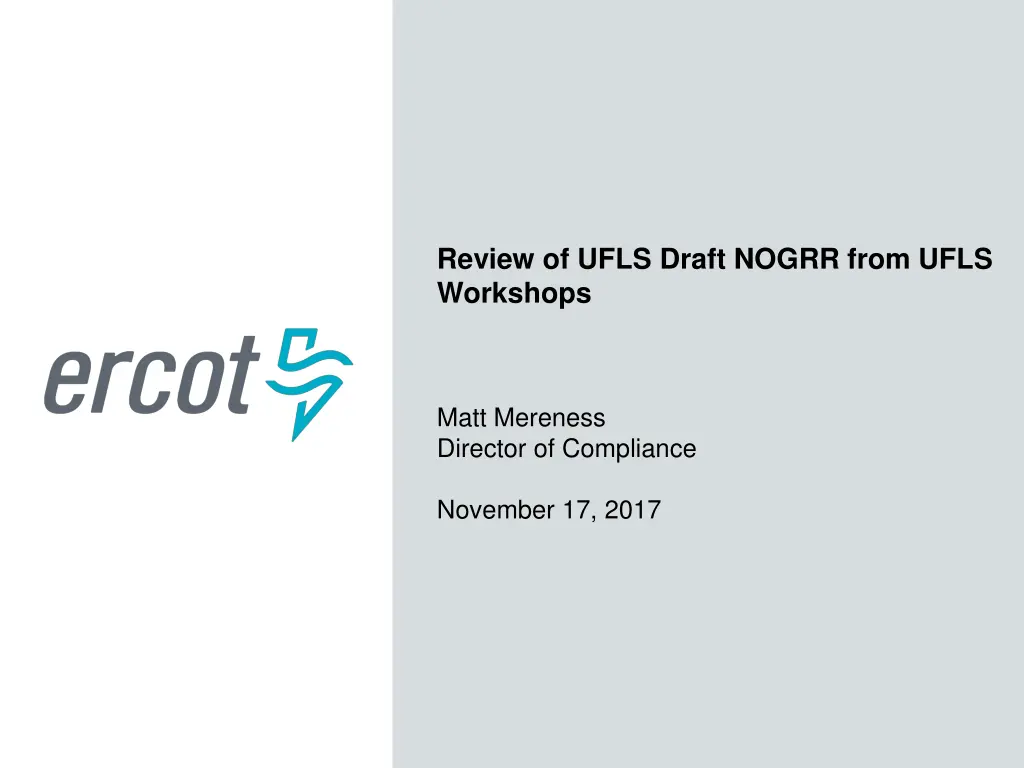
Review of UFLS Draft NOGRR From UFLS Workshops
Recap of key discussions and action items from UFLS workshops regarding ERCOT UFLS program clarifications, proposed changes, NERC requirements, ERS data, and compliance considerations led by Matt Mereness. ERCOT's efforts towards enhancing transparency in ERS data distribution are highlighted.
Download Presentation

Please find below an Image/Link to download the presentation.
The content on the website is provided AS IS for your information and personal use only. It may not be sold, licensed, or shared on other websites without obtaining consent from the author. If you encounter any issues during the download, it is possible that the publisher has removed the file from their server.
You are allowed to download the files provided on this website for personal or commercial use, subject to the condition that they are used lawfully. All files are the property of their respective owners.
The content on the website is provided AS IS for your information and personal use only. It may not be sold, licensed, or shared on other websites without obtaining consent from the author.
E N D
Presentation Transcript
Review of UFLS Draft NOGRR from UFLS Workshops Matt Mereness Director of Compliance November 17, 2017
UFLS Discussion outline Recap of key issues to date on clarifying ERCOT UFLS Program ERS Proposed changes Review current draft NOGRR Appendix 2016 and 2017 UFLS Survey results NERC requirement excerpt Potential Load Resource data to provide Overarming and ERS questions 2 PUBLIC
Recap- Summary of UFLS workshops Key discussions to date Problem statement- 2016 OWG issue over OpGuide 2.6.1 on inclusion and exclusion of Load At least 25% of the ERCOT System Load that is not equipped with high-set under-frequency relays shall be equipped at all times with provisions for automatic under-frequency load shedding. The under-frequency relays shall be set to provide Load relief as follows: 5%, 10%, 10% of ERCOT System Load Recognize there are at least two scenarios of UFLS being activated Sudden event: normal day but then significant loss of generation (starting point of 60Hz and no LR deployed) Slow-burn event: system is in emergency operations (EEA2), LR deployed, and then loss of generation ERCOT conclusion that in both cases, need for 25% of armed UFLS to arrest frequency ERCOT view that as frequency drops from 60 to 59.7 to 59.3, that the measurement of 25% response is tied to what the Load was when crossing 59.3 and initiating UFLS levels. Agreement that annual Compliance survey measurement should align as closely as possible with expected Operations compliance (post event reports and analysis). ERCOT was requested to create initial NOGRR draft reflecting operational expectations ERCOT was requested to provide inventory of LRs in DSP footprint ERCOT noted this is in network model but can also be provided ERCOT asked about providing historical LR trends/deployments ERCOT offered to provide annually if market can agree how to summarize (min, max, avg, annual, etc) ERCOT asked about providing Load Resource telemetry to TO/DSPs ERCOT asked about ERS information for TDSPs to understand location and impacts Is DSP or TO the appropriate role/definition for compliance in the NOGRR? 3 PUBLIC
Action Items from Aug/Sept OWG on ERS Can ERCOT provide more ERS data for improved transparency? From: Krein, Steve Sent: Monday, October 09, 2017 4:37 PM To: 1 Operations Working Group <operationswg@lists.ercot.com> Cc: Garza, Thelma <Thelma.Garza@ercot.com>; Patterson, Mark <Mark.Patterson@ercot.com>; Mereness, Matt <matt.mereness@ercot.com> Subject: ERS Reports Distribution OWG Participants, In support of OWG s request for more ERS data to support Market Participants analysis of potential UFLS changes, ERCOT staff has prepared and distributed a sample of new reports for summarizing the ERS procurement for the October 2017 to January 2018 contract period. For TDSPs in the competitive choice areas, the breakdown was done at a transmission substation level based on the station assignments provided to ERCOT for each ESIID. These reports separate ERS Load and ERS Generation into separate categories and consists of an aggregated value for each station. In the case of the NOIEs, the breakdown was done at a substation level if known, otherwise the aggregated numbers are based on zip codes as provided on the ERS procurement documentation submitted by the QSE. In the case of the NOIEs, the TDSP listed will typically be the DSP that serves the customer load. The reports were sent to the Authorized Representative for each TDSP. Questions regarding the reports should be directed to Thelma Garza (512.248.3836). ERCOT plans to be available at the next meeting of the OWG to discuss the reports and any feedback Market Participants may have on this subject, and the value of producing these reports in going forward. Steve Krein Senior Market Operations Engineer ERCOT 4 PUBLIC
Current ERS TDSP Report Site-level information Qsename Resource Name Esiid, Site name, Street, City, Zip code TDSP interconnection agreement year (Generator Only) ERS Obligation per time period (YES or leave BLANK) ERS Service type Weather-Sensitive ERS-10 Non-Weather-Sensitive ERS-10 Weather-Sensitive ERS-30 Non-Weather-Sensitive ERS-30 Resource type (Load or Generator) Nov 17 OWG Meeting 5 PUBLIC
Proposed Additional Tab(s) to current TDSP Report per OWG s discussion Additional tab(s) To TDSP s in competitive areas Report Aggregated ERS MW Obligation by station code By the following ERS resource types: Weather-Sensitive Load, Non-Weather-Sensitive Load, Generator To NOIEs Report Aggregated ERS MW Obligation by zip code By the following ERS resource types: Weather-Sensitive Load, Non-Weather-Sensitive Load, Generator NPRR will be required to include the additional information as part of ERS routine reporting process. ERCOT recommends replacing current report with report proposed herein Nov 17 OWG Meeting 6 PUBLIC
Proposed Additional Tab(s) per OWGs discussion ERS Obligation by Station code and/or Zip code TDSP Name ERS resource type Station Code/Zip code ERS_MW_TP1 . ERS_MW_TP6 Aggregated ERS obligation for each time period (MW) Nov 17 OWG Meeting 7 PUBLIC
Proposed ERS TDSP Report NON-WS LOAD WS LOAD Methodology Step 1 Disaggregation GENERATOR Generator Load The assigned portion of an ERS Generator obligation will be based on eachgenerator s name plate rating Assign an equal portion of an ERS Resources Obligation to each site in the resource Step 2 Aggregation Sum the assigned portion to each site by station code (if in competitive area), zip code (if in NOIE area) as well as service type (NON-WS Load, WS Load and Generator) Step 3 By Time Period Perform Step 1 & 2 for each ERS Time Period Nov 17 OWG Meeting 8 PUBLIC
Review current NOGRR version Summary of changes Purposeful in separating (1) and (2) between actual event and survey In actual event, compliance with system Load measured at 59.3 Hz (2.6.1(1)). In annual survey, compliance with system Load at survey time (2.6.1(2)). ERCOT agreeable to allowing totals to roll into next tier Moved STEC s language on deployment amounts into survey section (2). Inserted ability for ERCOT to request redistribution if any reliability issues identified in survey NOGRR adds ERCOT requirement to annually provide registered Load Resources and capacity in TO/DSP footprint Question of proper alignment of DSP and TO responsibilities Does not currently include 2 concepts discussed in workshops Provision of trends of Load Resource status in TO/DSP footprint (eg, min, max, avg responsibility) could be added with no project impacts to add Provision of telemetry of LR status to TO/DSP project impacts NPRR would be needed for ERS reporting changes discussed today 9 PUBLIC
APPENDIX: - 2016 and 2017 UFLS Survey results - NERC requirement excerpt - Potential Load Resource data to provide - Overarming and ERS questions 10 PUBLIC
Appendix- 2016 & 2017 UFLS Survey Results ERCOT Compliance coordinates and conducts an annual survey with the TSPs and DSPs to ensure that the required automatic under-frequency load shed circuits are configured to provide the appropriate load relief in an under- frequency event as required by table below from Operating Guides 2.6.1(1) Requirements for Under-Frequency Load Shedding: Frequency Threshold Load Relief 59.3 Hz 5% of the ERCOT System Load (Total 5%) 58.9 Hz An additional 10% of the ERCOT System Load (Total 15%) 58.5 Hz An additional 10% of the ERCOT System Load (Total 25%) 2016 results were 7.2% / 12.2% / 12.6% for total of 31.9% 2017 results were 7.8% / 13.2% / 13.2% for total of 34.1% 11 PUBLIC
Appendix-NERC Requirement NERC standard PRC-006-2 Automatic Underfrequency Load Shedding: Requirement 3. Each Planning Coordinator shall develop a UFLS program, including notification of and a schedule for implementation by UFLS entities within its area, that meets the following performance characteristics in simulations of underfrequency conditions resulting from an imbalance scenario, where an imbalance = [(load actual generation output) / (load)], of up to 25 percent within the identified island(s). Requirement 9. Each UFLS entity shall provide automatic tripping of Load in accordance with the UFLS program design and schedule for implementation, including any Corrective Action Plan, as determined by its Planning Coordinator(s) in each Planning Coordinator area in which it owns assets. [VRF: High][Time Horizon: Long-term Planning] Measurement 9. Each UFLS Entity shall have dated evidence such as spreadsheets summarizing feeder load armed with UFLS relays, spreadsheets with UFLS relay settings, or other dated documentation that it provided automatic tripping of load in accordance with the UFLS program design and schedule for implementation, including any Corrective Action Plan, per Requirement R9. 12 PUBLIC
Appendix- Potential Load Resource data to be provided TDSP shown on Registration Form TDSP Duns From the Load Resource Asset Registration Form Dispatch Asset Code ESIID (Load Resources for NOIEs will have a non-settlement ESIID) Station the Load Resource is mapped to in the Network Operations Model PTI Number Transmission Transformer Load Name Maximum Registered Interruptible Load Historical Data (more analysis needed) Average hourly RRS Responsibility for LR during a predefined date range Maximum RRS Responsibility during the same time period 13 PUBLIC
Overarming and ERS (Responses from Sept OWG) 1. Is there any risk of overarming and overshooting on UFLS? ERCOT does perform planning studies that include dynamic simulations using DWG model that includes equipped UFLS circuits and Load Resources. The dynamic study is performed on different models, including High Wind, Low-Load and to date ERCOT has not observed any over-shoot issues related to this study. Current ERCOT surveys do reflect a certain amount of overshoot at the different levels (2-3%), and with the current proposed changes allowing movement across tiers, the overshoot may be reduced overall. 2. Has ERCOT studied the impacts of ERS deployments? ERCOT has not studied ERS deployments in current dynamic models Current ERS procurement is approximately 800MW When compared to the current excess 2-3% UFLS capacity at each tier this is not a significant number For 30,000MW load, 600-900MW per tier represent the 2-3% at each tier 14 PUBLIC

